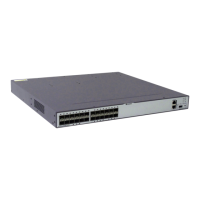2.2 RIP Features Supported by the S6700
The RIP features supported by the S6700 include RIPv1, RIPv2, split horizon, poison reverse,
and multi-instance.
The S6700 supports the following RIP features:
l RIPv1 and RIPv2
l RIP multi-instance, which functions as an internal routing protocol for VPNs and runs
between CEs and PEs in MPLS L3VPN networks
2.3 Configuring Basic RIP Functions
To implement RIP features, configure basic RIP functions including enabling RIP, specifying
the network segment in which RIP runs, and setting the RIP version.
2.3.1 Establishing the Configuration Task
Before configuring basic RIP functions, familiarize yourself with the applicable environment,
complete the pre-configuration tasks, and obtain the required data. This can help you complete
the configuration task quickly and accurately.
Applicable Environment
Configuring basic RIP functions allows you to enjoy certain RIP features.
Pre-configuration Tasks
Before configuring basic RIP functions, complete the following tasks:
l Configuring the link layer protocol
l Configuring IP addresses for interfaces to ensure that neighboring nodes are reachable at
the network layer
Data Preparation
To configure basic RIP functions, you need the following data.
No.
Data
1 RIP process ID
2 Network segment in which the RIP interface resides
3 RIP version number
2.3.2 Enabling RIP
Creating RIP processes is the prerequisite to performing RIP configurations.
S6700 Series Ethernet Switches
Configuration Guide - IP Routing 2 RIP Configuration
Issue 01 (2012-03-15) Huawei Proprietary and Confidential
Copyright © Huawei Technologies Co., Ltd.
26

